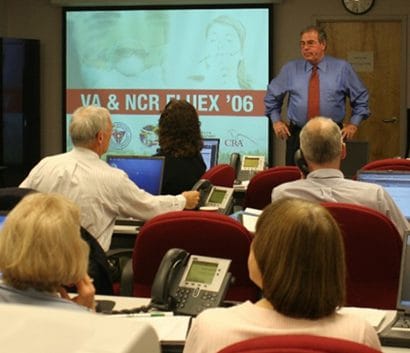Bob Mauskapf

Robert (Bob) P. Mauskapf
Director, Office of Emergency Preparedness
Virginia Department of Health

Where were you on 9/11? Were you part of the emergency response?
I was home, retired from two careers related to military and private sector logistics/supply chain management. I also was recovering from a significant health scare. I had nothing to do with the immediate response to 9/11, but I was motivated to participate in the response to emerging threats.
What was your introduction to public health preparedness? How did you get involved with PHEP?
I don’t differentiate between overall emergency preparedness and public health preparedness. After 9/11, I wanted to pursue emergency preparedness and homeland security. After receiving several job offers, I chose to work for the Virginia Department of Health (VDH).
During my 31-year United States Marine Corps career as an infantry officer, I helped establish and operate refugee centers and provided military support to civilian agencies in civil emergencies. While a student at the Army War College, I pursued an advanced degree in public administration.
In the private sector, I championed “just-in-time” logistics, routinely distributing pharmaceuticals from order to on-shelf in less than 24 hours. This experience convinced me that the Strategic National Stockpile was an intriguing and viable initiative.
What do you do on a day-to-day basis related to PHEP activities?
I serve as director in the Office of Emergency Preparedness at VDH and principal investigator for several grants. They include PHEP, the U.S. Department of Health and Human Services (HHS) Administration for Strategic Preparedness and Response’s (ASPR’s) Hospital Preparedness Program, and one related to workforce development.
I also serve as
- staff coordinator for VDH Incident Command structures.
- the Emergency Support Function (ESF)-8 lead for state emergency response.
- state coordinator working with all regional and local health district emergency coordinators.
- principal liaison to CDC/DSLR, HHS/ASPR, and the Federal Emergency Management Agency (FEMA) at the national and regional levels.
Over your career, what changes have you seen in PHEP? How has public health preparedness evolved?
During my career, I witnessed an important transition from bioterrorism response to all-hazards response.
I saw a greater integration of emergency preparedness and response within state and local public health. I observed the removal of functional and jurisdictional barriers.
I also noticed that the field of preparedness and response took on a “whole-of-government approach” of working to address common problems across multiple agencies. That type of approach was then used with private-sector partners.
How has PHEP supported preparedness in your jurisdiction? What’s the most significant impact PHEP has made in terms of your jurisdiction’s ability to respond to a public health threat?
PHEP provides the context through which the state health agency organizes preparedness strategies and activities. The influence of PHEP and the credibility earned through years pushed VDH into a state leadership role in the longest, most impactful, most expensive, most destructive emergency of our time—COVID-19. We did not change our organization or strategies, tactics, techniques, procedures, and command relationships for COVID-19. Instead, we evolved based on best practices and lessons learned.
Reflecting on your career in public health emergency preparedness, what accomplishments are you most proud of?
I’m most proud of the ability of our team to manage multiple emergencies simultaneously without “dropping a ball.” We excel at team building. We maintain credibility and continuity throughout our responses. I like to say we are “Hotel California” in that our staff can “check out” but they never leave.
I’m proud of our team and agency resilience. Our organization is agile, timely, and responsive. We have a large, talented group of people. Our volunteers and Medical Reserve Corps (MRC) networks multiply our impact.
Other than COVID-19, what public health emergency response experience stands out in your memory and why?
Hurricane Isabel (2003) stands out in my memory. It was our agency’s coming-of-age emergency response event. Our agency deployed based on PHEP principles. We dealt with everything from state and local workforce mobilization, to food and water safety, to vector control, to public communications about health-related threats. We also dealt with evacuation of healthcare facilities, shelter support, volunteer management, behavioral health support, and fatality management.
This memorable response started a standard of excellence that has continued since then.
How do you maintain momentum and prevent personal burnout in the preparedness field? How do you do the same for your team?
At 75, I am thriving on the challenges and rewards of preparedness work. I believe this attitude is “infectious.” Things that work well for our team include a centralized command structure with decentralized execution of tasks.
We assign tasks that are the best fit for the employee. We find, develop, and promote talented individuals within our workforce. We reward where possible and demonstrate trust and confidence. It works well to engage on personal and team levels.